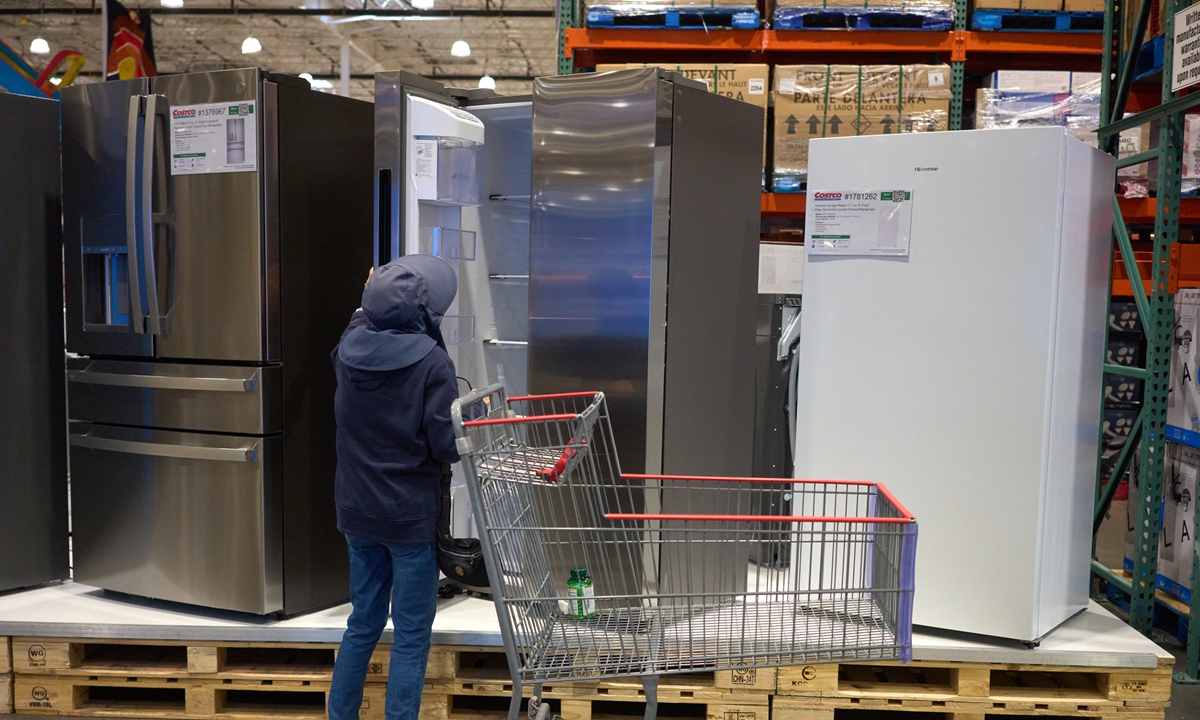
A person shops for appliances at a store in Los Angeles, California, US, May 6, 2025. Some companies have said they have been left with no choice but to raise prices as they pay more to import goods among US' tariffs, while other companies have said they will soon run out of inventory for certain products because they have paused orders from China. Photo: VCG
A range of imported household appliances, including dishwashers, washing machines, refrigerators and more, became subject to a 50 percent US tariff on steel and aluminum starting on Monday, according to a June 13 Federal Register notice from the US Commerce Department. Chinese experts criticized the move as economically irrational and politically short-sighted, saying it ultimately forces the general public to bear rising costs under the guise of job creation.
This round added eight product lines: combined refrigerator-freezers; small and large dryers; washing machines; dishwashers; chest and upright freezers; cooking stoves, ranges and ovens; food waste disposals; and welded wire racks, according to a June 13 Reuters report.The notice specified that the tariff applies not to the appliances as finished products, but specifically to the steel or aluminum components they contain.It is the second time since the Trump administration initially ratcheted up tariffs on imported steel and aluminum that the US has expanded the list of derivative products affected by the import levies -- first to a rate of 25 percent starting in March and then to 50 percent this month. Just before the first round of duties was set to take effect in March, nearly 300 product categories were added to the list, ranging from horseshoes to bulldozer blades, according to Reuters."Raising tariffs under the pretext of protecting domestic industries is, in essence, a form of exploitation of consumers," Zhou Mi, a senior researcher at the Chinese Academy of International Trade and Economic Cooperation, told the Global Times on Monday. "While it may provide short-term shelter for a handful of US steel producers, it ultimately forces the broader public to shoulder higher costs."Gao Lingyun, an expert at the Chinese Academy of Social Sciences in Beijing, agreed, saying the number of jobs supposedly created by these tariffs is negligible compared with the overall disruption. "Each job comes at a staggering cost of $817,000—clearly a case of picking up sesame seeds while dropping watermelons, as a Chinese saying goes."Zhou noted that the repeated tariff hikes—from 25 to 50 percent—reflect the declining marginal utility of such protectionist measures. "Such unpredictable shifts damage the credibility of the US business environment and erode global supplier confidence."Gao criticized Washington's industrial policy, saying the US should be focusing on developing high-value-added sectors instead of reverting to inefficient, low-end manufacturing. "This does nothing to support structural upgrades and is unlikely to improve long-term competitiveness," he said.During US President Donald Trump's first term, he imposed tariffs of 25 percent on steel and 10 percent on aluminium imports, citing "national security" concerns. However, a study by the Federal Reserve Bank of New York showed that since 2018, the US government's unilateral imposition of trade barriers—including steel and aluminum tariffs—on its trading partners, along with the retaliatory measures these actions provoked, led to job losses in the US manufacturing sector, according to a February report by the Xinhua News Agency.Zhou warned that the inflationary impact of steel tariffs is likely to ripple through the US economy. "Steel is a foundational material across countless supply chains. Once tariffs are imposed, the cost increase spreads downstream, affecting manufacturers, builders, and eventually ordinary households."Gao added that the decision runs counter to sound economic principles. "Even if a few jobs are created in the short term, they are unlikely to last in the face of structural inefficiencies. The costs far outweigh the benefits.
